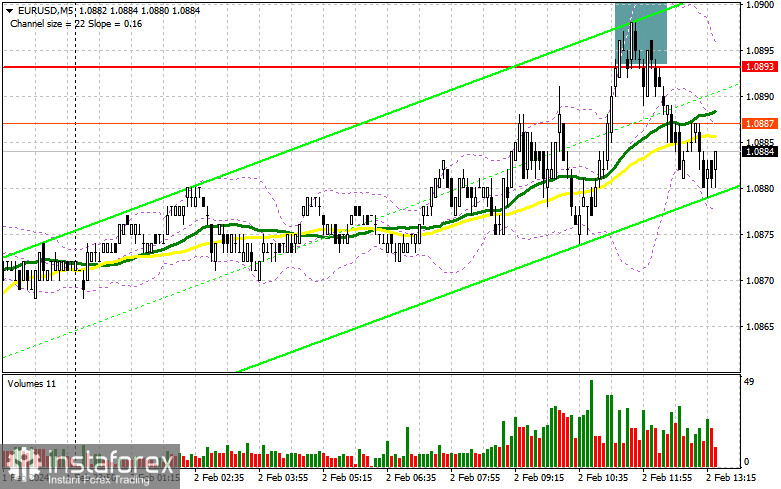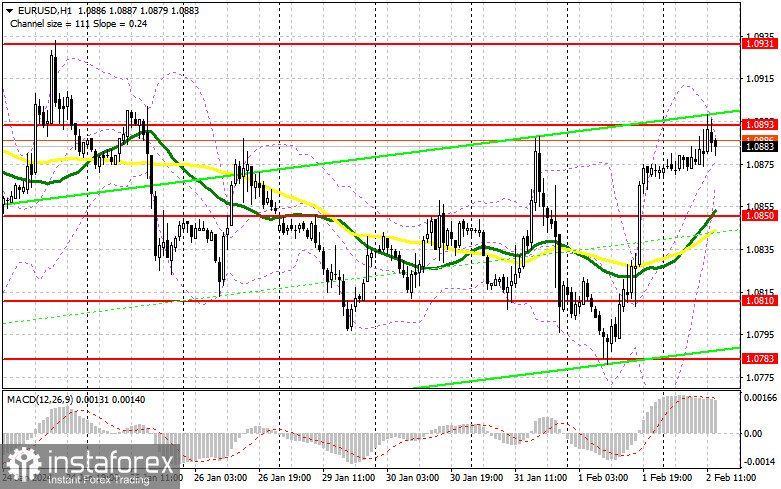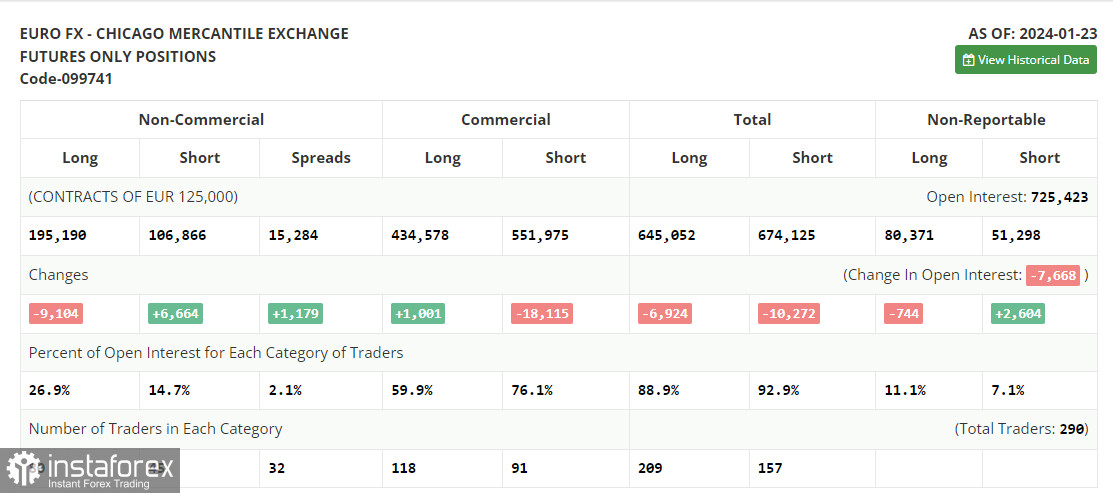In my morning forecast, I highlighted the level of 1.0893 and planned to make decisions regarding market entry based on it. Let's look at the 5-minute chart and analyze what happened there. The upward movement and the formation of a false breakout around 1.0893 led to a sell signal, but after a 13-point downward movement, the pressure on the pair decreased. The reason for the weak activity of sellers in the market is clear to everyone. The technical picture still needs to be revised for the second half of the day.

To open long positions on EUR/USD, the following is required:
No one is in a hurry to sell the euro, especially in anticipation of important US labor market statistics. The unemployment rate and non-farm payrolls will determine the pair's direction. Weak reports with an increase in unemployment and a sharp reduction in the number of employed - all will lead to a new strengthening of EUR/USD, which I plan to take advantage of. If the data turns out to be stronger than forecast, the dollar will undoubtedly regain some of the positions lost yesterday.
I want to act on the purchase around the support level of 1.0850, which was formed at the end of yesterday. Only the formation of a false breakout would be a suitable entry option for me, counting on a strong spike in the pair upwards toward 1.0893, which has yet to be surpassed so far. A breakthrough and update from top to bottom of this range will provide an opportunity to buy with the development of a more powerful upward correction trend and the prospect of updating 1.0931. The ultimate target will be a maximum of 1.0966, where I will make a profit. However, this level will only be possible with weak US labor market data. In the case of a decline in EUR/USD and no activity at 1.0850 in the second half of the day, where the moving averages also intersect, the pressure on the pair will increase. In this case, I plan to enter the market only after forming a false breakout around 1.0810. I will consider opening long positions immediately on the rebound from 1.0783 with the goal of an ascending correction within the day by 30-35 points.
To open short positions on EUR/USD, the following is required:
The bears coped with the tasks set for the first half of the day, but they still needed to achieve a larger correction. Protecting 1.0893 remains their priority for the American session. The formation of a false breakout there, similar to what I discussed above, may lead to a new downward movement of the pair towards 1.0850, where slightly below the moving averages pass, already playing on the side of buyers. Only a breakthrough and consolidation below this range against the backdrop of strong labor market statistics, which is unlikely, and a reverse test from bottom to top will provide another selling point with a pair collapse towards 1.0810. The ultimate goal will be the minimum of 1.0783, where I will take profit. In the case of further upward movement of EUR/USD in the second half of the day and the absence of bears at 1.0893, which is likely to happen, demand for EUR/USD will strengthen. In this case, I will postpone the sales until the next resistance test at 1.0931. I will also sell there, but only after an unsuccessful consolidation. I plan to open short positions immediately on the rebound from 1.0966 with the goal of a descending correction by 30-35 points.


Indicator Signals:
Moving Averages
Trading is conducted above the 30 and 50-day moving averages, indicating further pair growth.
Note: The author considers the period and prices of moving averages on the hourly chart H1 and differs from the general definition of classical daily moving averages on the daily chart D1.
Bollinger Bands
In case of a decline, the lower boundary of the indicator, around 1.0850, will act as support.
Indicator Descriptions:
- Moving Average (determines the current trend by smoothing volatility and noise). Period 50. Marked on the chart in yellow.
- Moving Average (determines the current trend by smoothing volatility and noise). Period 30. Marked on the chart in green.
- MACD Indicator (Moving Average Convergence/Divergence — Convergence/Divergence of Moving Averages) Fast EMA period 12. Slow EMA period 26. SMA period 9.
- Bollinger Bands. Period 20.
- Non-commercial traders - speculators, such as individual traders, hedge funds, and large institutions, use the futures market for speculative purposes and meet certain requirements.
- Long non-commercial positions represent the total long open position of non-commercial traders.
- Short non-commercial positions represent the total short open positions of non-commercial traders.
- The total non-commercial net position is the difference between non-commercial traders' short and long positions.
 English
English 
 Русский
Русский Bahasa Indonesia
Bahasa Indonesia Bahasa Malay
Bahasa Malay ไทย
ไทย Español
Español Deutsch
Deutsch Български
Български Français
Français Tiếng Việt
Tiếng Việt 中文
中文 বাংলা
বাংলা हिन्दी
हिन्दी Čeština
Čeština Українська
Українська Română
Română

